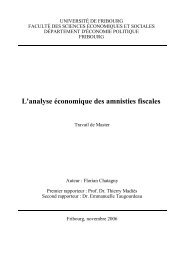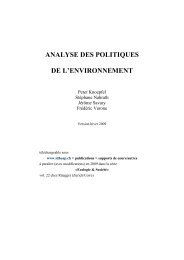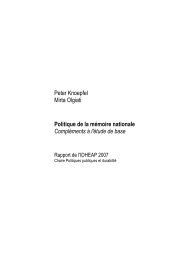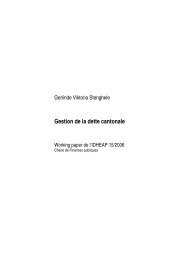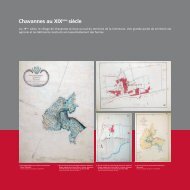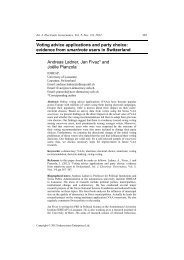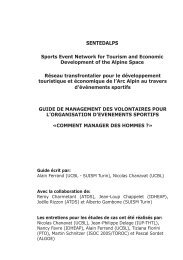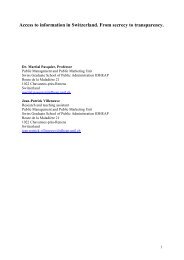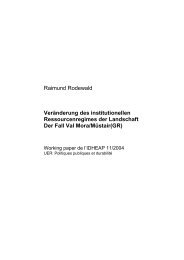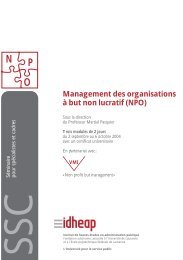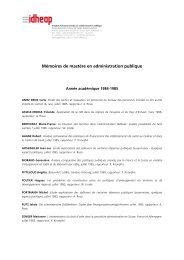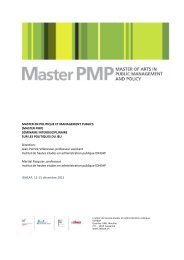Historical Analysis of Institutional Regimes in Switzerland ... - IDHEAP
Historical Analysis of Institutional Regimes in Switzerland ... - IDHEAP
Historical Analysis of Institutional Regimes in Switzerland ... - IDHEAP
Create successful ePaper yourself
Turn your PDF publications into a flip-book with our unique Google optimized e-Paper software.
10<br />
provided by a given resource and this becomes a collective problem because <strong>of</strong> the risk<br />
<strong>of</strong> local, regional or global overuse.<br />
• In a “complex IR situation”, we can already observe differentiation on the basis <strong>of</strong> the<br />
specific uses <strong>of</strong> the resource (goods and services provided by the resource) and the<br />
comb<strong>in</strong><strong>in</strong>g <strong>of</strong> the (clarified, redef<strong>in</strong>ed) property and use rights with more detailed policy<br />
design <strong>in</strong> terms <strong>of</strong> substantive content <strong>of</strong> the correspond<strong>in</strong>g protection and use policies.<br />
The differentiation <strong>of</strong> the aims <strong>of</strong> natural resource protection and use policy designs will<br />
probably move from negative statements such as “no environmental nuisances” (=<br />
general police clause) towards more quantitative, positively formulated prescriptions on<br />
the desired quality <strong>of</strong> the resource (e.g. ambient air quality standards) and, <strong>in</strong> the next<br />
step, <strong>in</strong> limit<strong>in</strong>g the consumption <strong>of</strong> specific goods and services <strong>in</strong> time and space <strong>in</strong> terms<br />
<strong>of</strong> general quantitative consumption quotas. The now ma<strong>in</strong>ly heterogeneous demands and<br />
the sum <strong>of</strong> the diverse (private-)use rights could lead to a crisis <strong>in</strong> and possibly even the<br />
collapse <strong>of</strong> the complex IR. Examples <strong>of</strong> such rivalrous and excessive uses can be found<br />
<strong>in</strong> the area <strong>of</strong> land (agriculture, construction zones, roads/railways etc.), water (fish<strong>in</strong>g,<br />
energy, agriculture etc.) and forest (biodiversity, recreation, timber etc.). It is safe to<br />
assume that this situation, which is characterised by <strong>in</strong>creas<strong>in</strong>gly <strong>in</strong>efficient and more<br />
complex IRs for various natural resources, can, at least, be found <strong>in</strong> <strong>Switzerland</strong> today.<br />
• One key theoretical and empirical question is whether it is possible to establish an IR<br />
which can take account <strong>of</strong> these varied heterogeneous demands and regulate the totality<br />
<strong>of</strong> threatened uses <strong>in</strong> such a way that it is possible to ma<strong>in</strong>ta<strong>in</strong> the capacity <strong>of</strong> the whole<br />
resource <strong>in</strong> question for the production <strong>of</strong> all the goods and services provided by the<br />
resource. We refer here to an “<strong>in</strong>tegrated IR situation” with use <strong>of</strong> natural resources<br />
which promote susta<strong>in</strong>ability. Integrated IRs make it possible to guarantee the<br />
transparent satisfaction <strong>of</strong> the heterogeneous use requirements and to conserve the<br />
resource stock.<br />
4.3 The development trajectories (development path) <strong>of</strong> <strong>Institutional</strong> Resource <strong>Regimes</strong><br />
In our op<strong>in</strong>ion, the historical emergence <strong>of</strong> an IR and the detection <strong>of</strong> different stages, as well as their<br />
result<strong>in</strong>g effects on the natural resource, are important topics for future research on resource<br />
susta<strong>in</strong>ability. By referr<strong>in</strong>g to the concept <strong>of</strong> a trajectory, patterns <strong>of</strong> tim<strong>in</strong>g and sequence are<br />
emphasised and the development path <strong>of</strong> IRs studied. With this procedure we implicitly assume that<br />
the capacity <strong>of</strong> actors to design <strong>of</strong> optimum <strong>in</strong>stitutions (as behaviour <strong>in</strong>centives) is limited and<br />
historically conditioned. Path dependence is by the way used to support the key claim, “that<br />
particular courses <strong>of</strong> action, once <strong>in</strong>troduced, are <strong>of</strong>ten virtually difficult or impossible to reverse even<br />
if their consequences prove to be disastrous” (Pierson 1997: 1).<br />
From a methodological perspective, the analytical concept <strong>of</strong> the IR can be def<strong>in</strong>ed as both a<br />
dependent variable (which factors <strong>in</strong>fluence the emergence and change <strong>of</strong> IRs?) and an <strong>in</strong>dependent<br />
variable (what are the effects <strong>of</strong> a particular IR on the users and susta<strong>in</strong>ability <strong>of</strong> a natural resource?).<br />
Hence, two types <strong>of</strong> hypothesis are required to expla<strong>in</strong> the historical development <strong>of</strong> IRs and natural<br />
resources (as, accord<strong>in</strong>g to our ma<strong>in</strong> postulate, both elements are related). Without mak<strong>in</strong>g any claim<br />
<strong>of</strong> be<strong>in</strong>g comprehensive, the follow<strong>in</strong>g exemplary hypotheses can be formulated on the genesis and<br />
transformation <strong>of</strong> IRs as well as on the effects <strong>of</strong> IRs:



